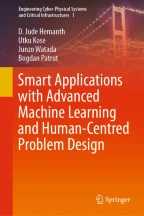PID Controller and Intelligent Control for Renewable Energy Systems

This chapter is intended for students and teachers who want to obtain a ba- sis for understanding how PID controllers can be used in renewable energy systems. During this chapter we are going to discuss topics like history and operation and function form of these controllers, we will also talk about the main applications that those have. On the other hand, we will also talk about different kinds of Renewable energy systems, so that in this way, we can gather all the previous topics and under-stand how PID controllers can be integrated into a renewable energy system and the advantages we would get from it.
This is a preview of subscription content, log in via an institution to check access.
Access this chapter
Subscribe and save
Springer+ Basic
€32.70 /Month
- Get 10 units per month
- Download Article/Chapter or eBook
- 1 Unit = 1 Article or 1 Chapter
- Cancel anytime
Buy Now
Price includes VAT (France)
eBook EUR 160.49 Price includes VAT (France)
Hardcover Book EUR 210.99 Price includes VAT (France)
Tax calculation will be finalised at checkout
Purchases are for personal use only

Role of Power Electronics and Optimization Techniques in Renewable Energy Systems
Chapter © 2021

Using AI and Classical Controllers for Improving the Renewable Energy Systems
Chapter © 2023

Using AI and Classical Controllers for Improving the Renewable Energy Systems
Chapter © 2022
References
- Agarwal T (2020, 11). PID controller : working, types, advantages its applications. Retrieved from https://www.elprocus.com/the-working-of-a-pid-controller/
- Alrikabi N (2014) Renewable energy types. J Clean Energy Technol 61–64 Google Scholar
- Amrouche SO, Rekioua D, Rekioua T, Bacha S (2016) Overview of energy storage in renewable energy systems. Int J Hydrogen Energy 41(45):20914–20927 ArticleGoogle Scholar
- Ang KH, Chong G (n.d.) Li Y (2005) PID control system analysis, design, and technology. IEEE Trans Control Syst Technol 13(4):559–576 Google Scholar
- Bajpai P (2018) Chapter 24 - process control. In: Ba-jpai P (ed) Biermann’s handbook of pulp and paper (third edition) , 3rd edn, pp 483–492. Elsevier. Retrieved from https://www.sciencedirect.com/science/article/pii/B9780128142387000246 , https://doi.org/10.1016/B978-0-12-814238-7.00024-6
- Bansal HO, Sharma R, Shreeraman P (2012) Pid controller tuning techniques: a review. J Control Eng Technol 2(4):168–176 Google Scholar
- Behera C, Banik A, Nandi J, Reddy GH, Chakrapani P, Goswami AK (2020) A probabilistic approach for assessment of financial loss due to equipment outage caused by voltage sag using cost matrix. Int Trans Electr Energy Syst 30(3):e12202 Google Scholar
- Borase RP, Maghade D, Sondkar S, Pawar S (2020) A review of pid control, tuning methods and applications. Int J Dynam Control 1–10 Google Scholar
- Control Tutorials for MATLAB and Simulink. (n.d.). Introduction: PID controller design. Retrieved from https://ctms.engin.umich.edu/CTMS/index.phpexample=Introduction§ion=ControlPID
- Elsisi M (2020) New design of robust pid controller based on meta-heuristic algorithms for wind energy conversion system. Wind Energy 23(2):391–403 ArticleGoogle Scholar
- Engineering O (2020, 10). What is a PID controller? Retrieved from https://www.omega.com/en-us/resources/pid-controllers
- Ho M-T, Lin C-Y (2003) Pid controller design for robust performance. IEEE Trans Autom Control 48(8):1404–1409 ArticleMathSciNetMATHGoogle Scholar
- Khodabakhshian A, Hooshmand R (2010) A new pid controller design for automatic generation control of hydro power systems. Int J Electr Power Energy Syst 32(5):375–382 ArticleGoogle Scholar
- Knospe C (2006) Pid control. IEEE Control Syst Mag 26(1):30–31 ArticleGoogle Scholar
- Libretexts (2021, 03). 9.2: P, I, D, PI, PD, and PID control. Retrieved from Google Scholar
- Mitra L, Swain N (2014) Closed loop control of solar powered boost converter with pid controller. In: 2014 IEEE international conference on power electronics, drives and energy systems (pedes), pp 1–5 Google Scholar
- Moradi M (2003) New techniques for pid controller design. In: Proceedings of 2003 IEEE conference on control applications, CCA 2003, vol 2. pp 903–908 Google Scholar
- Pacesila M, Burcea SG, Colesca SE (2016) Analysis of renewable energies in european union. Renew Sustain Energy Rev 56:156–170 ArticleGoogle Scholar
- Sahin AD (2004) Progress and recent trends in wind energy. Prog Energy Combust Sci 30(5):501–543 ArticleGoogle Scholar
- Sakurai T, Funato H, Ogasawara S (2009) Fundamental characteristics of test facility for micro hydroelectric power generation system. In: 2009 International conference on electrical machines and systems, pp 1–6 Google Scholar
- Sampaio PGV, González MOA (2017) Photovoltaic solar energy: conceptual framework. Renew Sustain Energy Rev 74:590–601 ArticleGoogle Scholar
- Seraji H (1998) A new class of nonlinear pid controllers with robotic applications. J Robot Syst 15(3):161–181 Google Scholar
- Zhao H-R, Guo S, Fu L-W (2014) Review on the costs and benefits of renewable energy power subsidy in china. Renew Sustain Energy Rev 37:538–549 ArticleGoogle Scholar
Author information
Authors and Affiliations
- Facultad de Ingenieria, Universidad Panamericana, Augusto Rodin 498, Ciudad de Mexico, 03920, Mexico Pedro Domínguez Alva & Jose Antonio Marmolejo Saucedo
- Facultad de Ciencias Economicas y Empresariales, Universidad Panamericana, Augusto Rodin 498, Ciudad de Mexico, 03920, Mexico Roman Rodriguez-Aguilar
- Pedro Domínguez Alva

